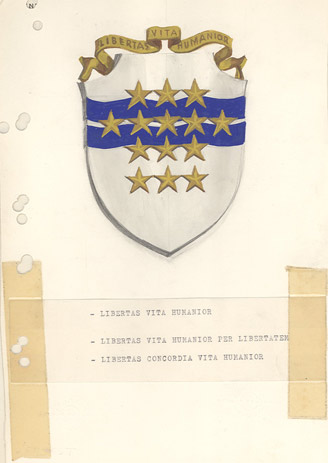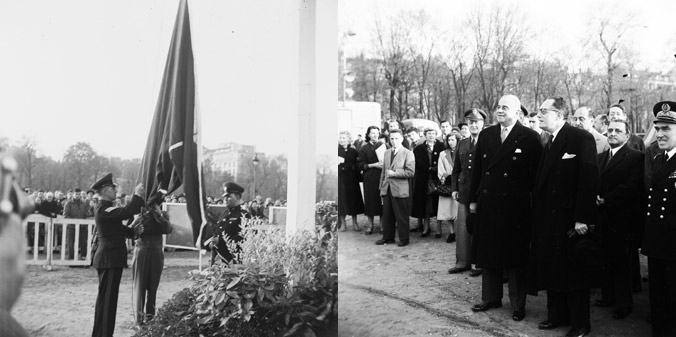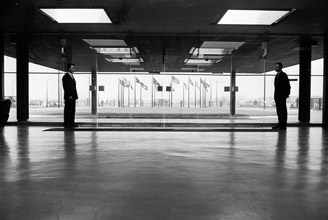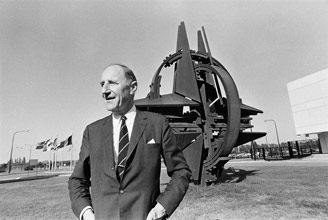A star is born
NATO’s forecourt sculpture, affectionately known as the “NATO Star”, is a unique and recognisable feature of the Alliance’s headquarters. Nestled within a crown of the flags of NATO member countries, the Star has become the implicit symbol of the Organization for the many visitors who use it as the backdrop for official and non-official photos taken during the Alliance’s 50-year stay in Brussels, Belgium.

A committee comprising solely female officers poses in front of the NATO Star, 12 November 1973. Right: flags at half-mast, honouring the victims of the Brussels terrorist attacks, 22 March 2016.
However, a closer look at the NATO Star reveals that it is not actually a bronze sculpture of a star, rather it is modelled after a stylised compass inspired by the emblem that serves as the official symbol of the North Atlantic Alliance. The origins of the NATO emblem date back to nearly three years after the birth of NATO in 1949. In August 1952, the newly created NATO Information Policy Working Group discussed the topic of adopting a visual symbol that would best represent the values of the Alliance. After several exchanges of views, the Working Group "agreed to recommend to the Council that there should be a NATO flag", and an emblem within it.
The birth of the NATO emblem involved many design proposals. The goal was to have an emblem that symbolised the principles of the Atlantic community. It was important to adopt an emblem that was acceptable to all the NATO members and reflected the values of the Alliance. Among the designs offered to NATO, the most intriguing involved a silver shield with 14 stars. The shield symbolised defence and protection, the two blue stripes represented the Atlantic Ocean and the 14 stars signified the 14 members of NATO at the time. But this design would require alteration of the emblem each time a new member joined the Alliance.

The proposed "shield" emblem.
Ultimately, none of the proposed designs were retained. The North Atlantic Council outlined guidance for selecting a NATO emblem to use on a flag. The emblem needed to be simple and striking in design. It also needed to illustrate the community of traditions and ideals which united the members of the North Atlantic community. Lastly, the emblem had to "bring home the peaceful purpose of the North Atlantic Treaty".
On 28 October 1953, the then NATO Secretary General, Lord Ismay, announced that the North Atlantic Council had adopted a design for the official NATO emblem. He explained that the emblem could be described as "a four-pointed star representing the compass that keeps us on the right road, the path of peace, and a circle representing the unity that binds together the 14 countries of NATO". The blue background represented the Atlantic Ocean and the circle symbolised unity.
To celebrate NATO's newly chosen emblem for the flag, a ceremony took place at the Atlantic Exhibition, Esplanade des Invalides, Paris, France on 9 November 1953.

NATO's first official flag-raising ceremony at the Esplanade des Invalides, Paris on 9 November 1953. Then NATO Secretary General Lord Ismay (right photo, centre) was present for the inauguration.
When NATO moved to Brussels, Belgium in 1967, the current headquarters was intended to be temporary, so the original construction did not include considerations for exterior décor. It was only after the North Atlantic Council decided in late 1969 to make the Brussels site a permanent home that the question was raised of lending a prestigious note to the empty courtyard of the main entrance.

Looking out onto the barren Cour d'honneur in 1970.
An initial proposal of constructing a large weather-roof at the main entrance was declined and NATO's consultant architects were invited to come up with an alternative solution to embellish the forecourt, now known as the Cour d'honneur. The architects returned to the Council with proposals based on two completely different motifs: the first motif was an architectural structure of an abstract character while the second motif was inspired by the NATO emblem. For the latter proposal, Belgian architect Raymond Huyberechts designed a stylised compass "Rose des vents" cut by two circles (representing the Old and New Continent) that would be made of a pre-oxidised steel whose red-brown tint would not be affected by atmospheric agents. The Council expressed their preference for this proposal when the model was presented at a meeting held on 17 March 1970.

On 1 October 1971, Joseph Luns became the first NATO Secretary General to take his photo with the Star.
The sculpture was erected during August 1971 and an opening reception took place on 10 September 1971. On his first day in office on 1 October 1971, Joseph Luns became the first NATO Secretary General to take his photo with the Star, unwittingly inaugurating a practice that would become a popular activity for all visitors to NATO headquarters.
The NATO Star was chosen as the key image for the special edition Belgian stamp issued on 31 March 1979 commemorating NATO's 30th anniversary.
To mark NATO's move to its new headquarters on the eve of the Alliance's 50 years in Brussels, the Belgian post will once again issue a special limited edition stamp on 11 October 2016. This commemorative stamp will showcase the façade of the new NATO headquarters, with the Star firmly installed in its new home surrounded by the flags of the NATO member countries.

left: The NATO Star was featured on the special edition Belgian stamp issued on 31 March 1979 commemorating NATO's 30th anniversary. right: A special limited edition stamp marking NATO's move to its new headquarters will be released on 11 October 2016.
